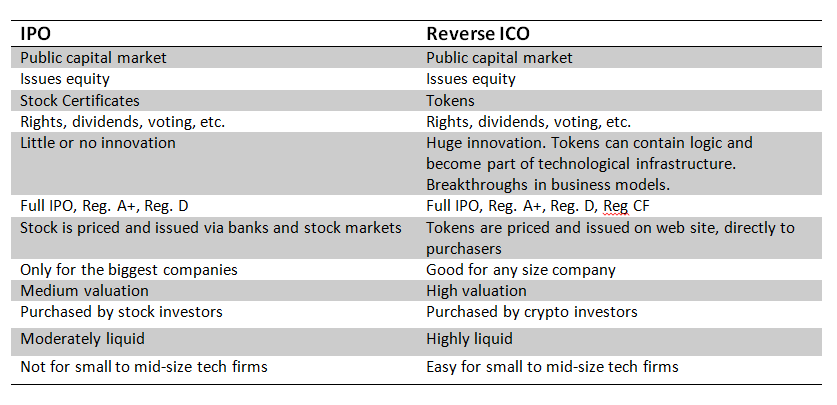Presented by Pathfinder Equity Systems
Depending on who you ask, IPOs have been steadily declining over the years because of regulatory tightening, increased costs, or Wall Street resistance to tech. This means less liquidity for entrepreneurs and less growth for the economy.
ICOs (Initial Coin Offerings) are growing in popularity, but so far virtually all are new ventures that tend to skirt securities law. Luckily there is an entirely different type of ICO — the Reverse ICO — which is fully compliant and ideal for established companies. The first Reverse ICOs are still a few months away, but the process is quite clear.
Reverse ICOs aren’t for startups and they don’t avoid being classified as a security. Quite the opposite, they are intended for existing, successful companies and are assumed to be securities from the start, with some extra innovation sprinkled on top.
They are almost identical to traditional IPOs, following the same regulations, audits, and disclosures, but issuing tokens (electronic equity) instead of traditional stock. Because tokens are a new technology, they are more liquid, more flexible, and open to innovation.
Most important, token-based equity, combined with token economic modifications to company business models, may offer significantly better valuation for the mid-size technology ventures not yet large enough for a traditional IPO. These sorts of companies are the bread and butter of the tech industry…and of VC portfolios.

The cryptocurrency investor profile
ICOs are made possible, of course, by ICO investors. They are an entirely new class of investor created by the unprecedented rise of Bitcoin and other cryptocurrencies. Seemingly overnight, software developers and Bitcoin enthusiasts have accumulated tens of billions of dollars, their holdings growing thousands of percent per year — so quickly that normal rules of finance don’t seem to apply. These new investors are technologically sophisticated, unimpressed by standard financial institutions, willing to invest millions on a hunch, and willing to give high valuations to firms that adopt next-wave blockchain technology.
Their investing motivations are different from the norm. They don’t care about standard metrics and are risk tolerant. Their primary concern is, of course, to make great returns, but also to extend the reach of the Bitcoin-style ecosystem and to support the technology industry. These investors are eager to convert mainstream tech companies to cryptocurrencies, and Reverse ICOs give them new lands to conquer.
Joining the young cryptocurrency traders are growing crowds of hedge fund and family fund investors, unable to resist thousand-percent gains. These newcomers want to invest in ICOs but they also want the familiar and the defensible. Reverse ICOs give them a new selection of bread-and-butter choices, less risky but still delicious, with which to assemble their portfolio.
How do reverse ICOs work?
Reverse ICOs are both familiar and quite different for anyone who has done public offerings. They use the same prescribed pathways, choosing to be full public offerings, Reg A+, Reg D, Reg CF. They follow the same steps as other equity offerings: Planning, audits, disclosures, prospectus, filings, etc.
Where they “fork” is at the marketing and sales phase. Unlike traditional stock offerings, token-based equity is sold via some type of token sale directly to investors (retail or qualified, as appropriate) via web or email-based sales. Secondary trading will be via SEC- certified token exchanges, a few of which are now being prepared for operations, for example t0.com, being tested currently by Overstock.com CEO Patrick Byrne.

Tokenomics
Most important is token economics. Tokens are used not only as equity but potentially as micropayments for services, as carriers of the technical protocol, and for whatever else token economic inventors can invent or reduce to code.
The wild world of software is set loose in the staid world of finance, leading to disruption of business models and entire industries. For the bread and butter mid-sized tech firm, token economics can gain market share, build networks, create open-source ecosystems, and offer other advantages. Tokens don’t just attract new investors; they can increase sales and confer technological superiority. That’s a potent combination.
Are there risks? Of course. All of this is brand new. The full Reverse ICO infrastructure isn’t quite ready, there is a need for technology and analysts to smooth and accelerate the Reverse ICO process, and there are regulatory details to clarify.
If the venture investment community and entrepreneurs create valuable, legal, and exciting ICOs that unlock funding and boost the national economy, with a process that protects small investors, then we believe the SEC and other regulators will be happy to join in, and a valuable new channel for capital growth will be created.
To learn even more about Reverse ICOs, join us for our webinar: “Reverse ICOs for VC Portfolio Exit” on Wednesday, October 4, 2017 at 11a.m. PST. Register here.
Tom Benson is CEO of Pathfinder Equity Systems. Pathfinder helps companies launch Reverse ICOs using artificial intelligence coupled to expert analyst teams, to create the optimal token economic designs and product/market fit, matched to the world’s top ICO investors.
Sponsored posts are content produced by a company that is either paying for the post or has a business relationship with VentureBeat, and they’re always clearly marked. Content produced by our editorial team is never influenced by advertisers or sponsors in any way. For more information, contact sales@venturebeat.com.

